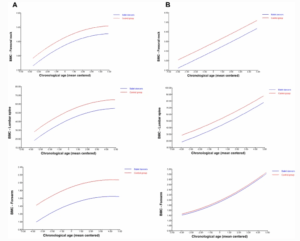24 Sep Associations between nutrition, energy expenditure and energy availability with bone mass acquisition in dance students: a 3-year longitudinal study
Amorim T , Freitas L, Metsios GS, Gomes TN, Wyon M, Flouris AD, Maia J, Marques F, Nogueira L, Adubeiro N, Koutedakis Y. Associations between nutrition, energy expenditure and energy availability with bone mass acquisition in dance students: a 3-year longitudinal study. Arch Osteoporos. 2021 Sep 24;16(1):141. doi: 10.1007/s11657-021-01005-5. PMID: 34561723.
, Freitas L, Metsios GS, Gomes TN, Wyon M, Flouris AD, Maia J, Marques F, Nogueira L, Adubeiro N, Koutedakis Y. Associations between nutrition, energy expenditure and energy availability with bone mass acquisition in dance students: a 3-year longitudinal study. Arch Osteoporos. 2021 Sep 24;16(1):141. doi: 10.1007/s11657-021-01005-5. PMID: 34561723.
Abstract:
Three years of study showed that female and male vocational dancers displayed lower bone mass compared to controls, at forearm, lumbar spine and femoral neck. Energy intake was found to positively predict bone mass accruals only in female dancers at femoral neck. Vocational dancers can be a risk population to develop osteoporosis.
Purpose: To determine whether risk factors normally associated with low bone mass in athletic populations (i.e. nutrition intake, energy expenditure and energy availability) are significant predictors of bone mass changes in vocational dance students.
Methods: The total of 101 vocational dancers (63 females, 12.8 ± 2.2 years; 38 males, 12.7 ± 2.2 years) and 115 age-matched controls (68 females, 13.0 ± 2.1 years; 47 males, 13.0 ± 1.8 years) were monitored for 3 consecutive years. Bone mass parameters were measured annually at impact sites (femoral neck, FN; lumber spine, LS) and non-impact site (forearm) using DXA. Nutrition (3-day record), energy expenditure (accelerometer), energy availability and IGF-1 serum concentration (immunoradiometric assays) were also assessed.
Results: Female and male vocational dancers had consistently reduced bone mass at all anatomical sites (p < 0.001) than controls. IGF-1 did not differ between male vocational dancers and controls, but female dancers showed it higher than controls. At baseline, calcium intake was significantly greater in female vocational dancers than controls (p < 0.05). Male vocational dancers’ fat and carbohydrate intakes were significantly lower than matched controls (p < 0.001 and p < 0.05, respectively). Energy availability of both female and male vocational dancers was within the normal range. A significant group effect was found at the FN regarding energy intake (p < 0.05) in female dancers. No significant predictors were found to explain bone mass differences in males.
Conclusion: Our 3-year study revealed that both female and male vocational dancers displayed lower bone mass compared to controls, at both impact and non-impact sites. The aetiology of these findings may be grounded on factors different than those usually considered in athletic populations.
Full Text Link:
https://pubmed.ncbi.nlm.nih.gov/34561723/
![]()


